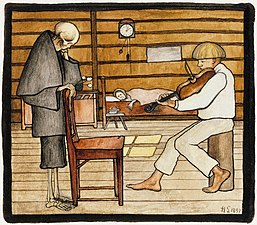Hugo Simberg
Hugo Simberg | |
|---|---|
 | |
| Born | Hugo Gerhard Simberg 24 June 1873 |
| Died | 12 July 1917 (aged 44) |
| Nationality | Finnish |
| Known for | Painter |
| Movement | Symbolism |
Hugo Gerhard Simberg (24 June 1873 – 12 July 1917) was a Finnish symbolist painter and graphic artist.
Life and career[]


Simberg was born on 24 June 1873, at Hamina (in the original Swedish: Fredrikshamn), the son of Colonel Nicolai Simberg and Ebba Matilda Simberg (née Widenius).[1] In 1891, at the age of 18, he enrolled at the Drawing School of the Viipuri Friends of Art, and he also studied at the Drawing School of the Finnish Art Society from 1893 to 1895, but in 1895 he decided to become the private pupil of Akseli Gallen-Kallela at his wilderness studio Kalela in Ruovesi. He studied under Gallen-Kallela for three periods between 1895 and 1897.[1][2]
In 1896 Simberg went to London, and in 1897 to Paris and Italy. During these years he exhibited several works at the Finnish Artists' autumn exhibitions, including Autumn, Frost, The Devil Playing and Aunt Alexandra (1898), which were well received. Critical success led to his being made a member of the Finnish Art Association and to his being appointed to teach at the Drawing School of the Viipuri Friends of Art.[1]
In 1904 he was commissioned to decorate the interior of St John's church in Tampere (now Tampere Cathedral), a project which he carried out with Magnus Enckell between 1904 and 1906. At the turn of the year 1907-08 he made a short visit to the United States.[1] He also designed the UPM-Kymmene logo, the Griffon (1899).
From around 1907 to 1913 he taught at the Drawing School of the Finnish Art Association at Ateneum.[1] In 1910, he married Anni Bremer. They had two children, Tom and Uhra-Beata, the latter of whom became a rya artist.[3]
He died in Ähtäri on 12 July 1917.[1][4] His biographer, Helena Ruuska, suspects that he battled an unknown disease, possibly syphilis, for a long time.[5][6][7][8]
Style[]
Simberg's paintings emphasize mainly macabre and supernatural topics.[9] Simberg's most famous painting is The Wounded Angel. Its titular character appears in the shape of a winged angel with a bandaged head, borne on a stretcher by two somberly dressed boys, one of whom looks toward the viewer with a serious expression. The painting is the best known of the artist's works and is especially famous in Finland.[1] The Finnish symphonic metal band Nightwish released in 2007 a music video influenced by this painting, "Amaranth".
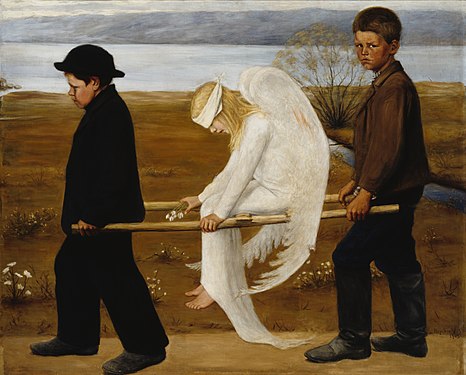
The Wounded Angel, 1903, voted Finland's "national painting" in a public vote organized by Ateneum in 2006[10]

The Garden of Death, 1896
Another famous painting is The Garden of Death, which, like many of Simberg's paintings, depicts a gloomy, otherworldly scene. The central figures are reminiscent of the classic black-clad Grim Reaper, but paradoxically are tending to gardens, traditionally symbols of birth or renewal.[11]
Gallery[]
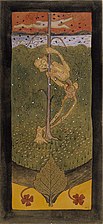
Autumn I, 1895

Autumn II, 1895

Poppy, 1896

On the Stream of Life, 1896

King Hobgoblin Sleeping, 1896

The Devil Playing, 1896[note 1]
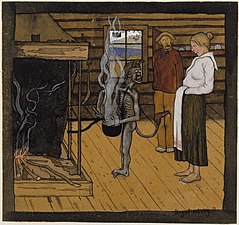
The Devil by the Pot (fi), 1897
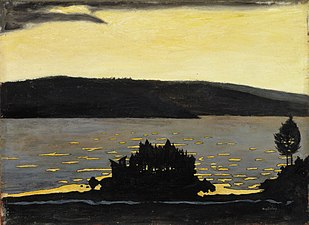
Spring Evening During the Break-Up of the Ice, 1897 (fi)
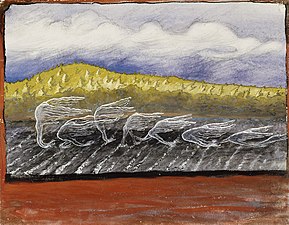
The Wind Blows, 1897

Aunt, 1898

The Poor Devil with its Twins, 1898, watercolor and oil

The Farmer's Wife and the Poor Devil with its Twins, 1899
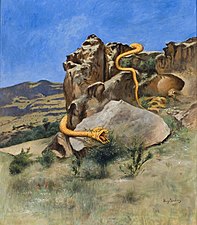
Yawning Snake, 1899, painted on his travels in the Caucasus

Potato Girl, 1901

Brothers, early 1900s
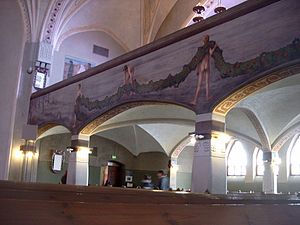
Simberg's frescoes in the Tampere Cathedral, 1904–1906

Sheep Girl, 1913

Towards the evening, 1913

The Peasant and Death at the Gates of Heaven and Hell, 1897, watercolor

Death and the Potato Peeler, unknown date
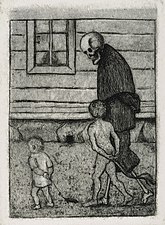
Playmates, 1897, line engraving on copper plate

At the Gate of Tuonela, 1898, oil on canvas

Dance on the Quay, 1899, gouache

Travel Companions, 1901, gouache
See also[]
- Golden Age of Finnish Art
- Art in Finland
Notes[]
References[]
- ^ Jump up to: a b c d e f g Syvälahti, Hanne. "Hugo Simberg elämäkerta". Didrichsen Museum. Retrieved 9 May 2020.
- ^ "Hugo Simberg". Artist Register. Artists' Association of Finland. Retrieved 23 May 2020.
- ^ Priha, Päikki (9 October 2006). "Simberg-Ehrström, Uhra (1914 - 1979)". Kansallisbiografia. Retrieved 23 May 2020.
- ^ Leiwo, Hanne (11 June 2017). "Hugo Simbergin kuolemasta 100 vuotta – muistomerkki paljastettiin kuolinpaikalla Ähtärissä". Yle. Retrieved 23 May 2020.
- ^ Jump up to: a b Ruuska, Helena (2018). Hugo Simberg: pirut ja enkelit. Werner Söderström. ISBN 9789510421826.
- ^ Halonen, Kaisa (22 November 2018). "Helena Ruuska penkoi Hugo Simbergin elämää kahden ja puolen vuoden ajan, mutta jotkut kysymykset jäivät vastausta vaille". Kirkko ja kaupunki. Retrieved 9 May 2020.
- ^ Varjus, Seppo (7 October 2018). "Hugo Simbergin enkeli antoi kasvot sisällissodan julmuudelle – vaikka synkkä salaisuus vei maalarin hautaan jo ennen". Ilta-Sanomat. Retrieved 9 May 2020.
- ^ Kotiranta, Pirkko (24 October 2018). "Vaiettu sairaus leimasi piruja ja enkeleitä maalanneen Hugo Simbergin elämää – uusi elämäkerta tuo julki monia puuttuvia palasia". Helsingin Sanomat. Retrieved 23 May 2020.
- ^ Kruskopf, Erik (20 June 2019). "Simberg, Hugo (1873 - 1917)". National Biography of Finland (in Finnish). Retrieved 9 May 2020.
- ^ "Haavoittunut enkeli on suomalaisten suosikkitaulu". Yle. 2 December 2006. Retrieved 23 May 2020.
- ^ Pellinen, Kirsi (2016). "Symbolistinen taidevalokuva tunneilmaisukeinona: Kuinka tulkita ja ilmaista symbolistisen taidevalokuvan keinoin?" (PDF). Theseus. OAMK. Retrieved 1 June 2020.
- ^ "355. Hugo Simberg (1873-1917) Kuoleman puutarha". Hagelstam. Retrieved 4 July 2020.
- ^ Simberg, Jan (2011). "Jan Simberg: Hugo Simberg - Maailmalla matkaaja, Tuonelan tutkaaja". Filosofiklubi. Retrieved 4 July 2020.
Further reading[]
- S. Koja, ed. Nordic Dawn: Modernism's Awakening in Finland 1890-1920 [exhibition catalogue] (2005. Prestel)
- Hugo Simberg 1873-1917, ed. A. Olavinen [exhibition catalogue, Ateneum Art Museum, Helsinki] (2000)
- Hugo Simberg 1873-1917. His life & art [CD-rom, Ateneum Art Museum, Helsinki] (2000)
External links[]
| Wikimedia Commons has media related to Hugo Simberg. |
- 1873 births
- 1917 deaths
- People from Hamina
- People from Viipuri Province (Grand Duchy of Finland)
- Swedish-speaking Finns
- Symbolist painters
- 20th-century Finnish painters
- 20th-century male artists
- Finnish male painters






















